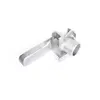Mobile:+86-311-808-126-83
Email:info@ydcastings.com
Exploring the Performance Benefits of Turbo Manifold Elbows in High-Performance Engine Applications
Understanding Turbo Manifold Elbows An Essential Component in Performance Engineering
In the realm of automotive performance engineering, turbo manifold elbows play a critical role in optimizing engine efficiency and power output. These components are essential in directing exhaust gases from the engine to the turbocharger, where they are used to spin the turbine and drive the compressor that forces more air into the engine. This process enhances the overall performance of an engine, making turbo manifold elbows vital for those seeking improved speed and power in their vehicles.
What Are Turbo Manifold Elbows?
Turbo manifold elbows are specifically designed pipe fittings that connect the exhaust manifold to the turbocharger. Their shape is often curved or angled, allowing for a smooth transition of exhaust gases, thereby minimizing turbulence. This turbulence can decrease the efficiency of exhaust gas flow, which is detrimental to turbo performance. Therefore, the design and construction of these elbows are paramount to ensuring optimal performance.
Typically, turbo manifold elbows are constructed from high-quality materials such as stainless steel or cast iron to withstand the extreme temperatures and pressures associated with turbocharged engines. The choice of material not only impacts durability but also affects heat dissipation and exhaust flow characteristics.
The Importance of Design
Design plays a significant role in the effectiveness of turbo manifold elbows. A well-designed elbow can improve the overall exhaust flow rate, reducing back pressure and allowing the turbocharger to spool more rapidly. This rapid spool-up time is crucial for reducing turbo lag, thus providing a more responsive driving experience. Performance engineers often incorporate features such as mandrel bends, which ensure that the diameter of the elbow remains constant throughout the curve, further enhancing exhaust flow efficiency.
turbo manifold elbows

Additionally, varying the radius of the elbow can substantially affect its performance. Smaller radius bends may induce higher turbulence, which, although permissible in certain high-performance scenarios, can lead to less effective exhaust flow in everyday driving conditions. Therefore, a balanced approach to the elbow's geometry is essential for achieving the desired performance gains.
Application in Performance Vehicles
Turbo manifold elbows are most commonly found in high-performance vehicles, including those designed for motorsport applications, as well as in modified street cars. In motorsports, where every ounce of power and responsiveness is critical, custom turbo manifold elbows are often utilized. These tailored components may feature unique geometries and materials suited to the specific demands of a racing environment.
In the world of street performance, enthusiasts often replace OEM (original equipment manufacturer) manifold elbows with aftermarket options to enhance performance. Upgrading to a more efficient elbow can lead to noticeable improvements in throttle response, acceleration, and overall engine flexibility. It allows drivers to tap into the full potential of their turbocharged engines, making the driving experience more exhilarating.
Conclusion
In conclusion, turbo manifold elbows are a vital component in the world of turbocharged engines, significantly influencing exhaust flow, turbo response, and overall vehicle performance. Their design and material considerations are crucial for optimizing efficiency and power output. For automotive enthusiasts and professionals alike, understanding the function and application of turbo manifold elbows can offer valuable insights into achieving maximum performance from turbocharged setups. Whether in motorsport applications or street performance vehicles, investing in high-quality, well-designed turbo manifold elbows can lead to substantial gains that enhance the driving experience.
-
Why Should You Invest in Superior Pump Castings for Your Equipment?NewsJun.09,2025
-
Unlock Performance Potential with Stainless Impellers and Aluminum End CapsNewsJun.09,2025
-
Revolutionize Your Machinery with Superior Cast Iron and Aluminum ComponentsNewsJun.09,2025
-
Revolutionize Fluid Dynamics with Premium Pump ComponentsNewsJun.09,2025
-
Optimizing Industrial Systems with Essential Valve ComponentsNewsJun.09,2025
-
Elevate Grid Efficiency with High-Precision Power CastingsNewsJun.09,2025











